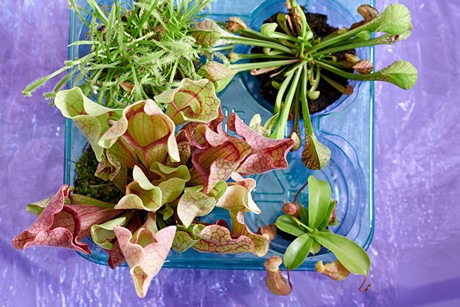Freakish to look at, unusual shapes and a good story: carnivorous plants attract spiders and insects with their colourful and bizarre appearance. They then catch and digest these creatures to obtain their nutrients. The best-known Carnivorous plants are the Venus flytrap (Dionaea muscipula), Sarracenia, sundew (Drosera) and pitcher plant (Nepenthes).
Their hunting techniques differ from plant to plant. The Venus flytrap uses trap leaves that slam shut incredibly quickly. With sundew the prey gets stuck to the leaves with tentacles. Ingenious: Sarracenia's leaves are pitcher-shaped and insects are trapped in them. Nepenthes also uses pitchers that hang from the ends of the leaves.

Credit: Thejoyofplants.co.uk
Origin
In the wild Carnivorous plants grow in fairly damp regions with nitrogen-poor soil such as swamps. Nepenthes does that in Southeast Asia, the Venus flytrap and Sarracenia come from North America, and sundew grows on all the continents apart from Antarctica.
Range and assortment
Pitcher plant (Nepenthes) is a soloist, whilst Venus flytrap (Dionaea), sundew (Drosera) and Sarracenia are often offered in mixed trays.
- Pitcher plant - This bizarre feature plant’s pitchers range in length from a few centimetres up to more than 30cm. They are actually distorted leaves that develop when the plant gets enough light. Insects find nectar on the lid above the pitcher and creep around into the pitcher in search of more. Just beneath the edge of the pitcher they find more nectar, but directly below it is a wax slide. They slip on this and so fall into the pitcher. The insects’ struggles activate the glands in the pitcher which then release a strong acid. In the space of two days this acid digests the insects. Only the insect’s casing remains. The plant grows on trees as an epiphyte.
- Venus flytrap is the most spectacular of the carnivorous plants. The leaves of this carnivore consist of two parts that can slam shut. Contact by an insect or small spider triggers the closing mechanism. However, the plant is not easily fooled. To be sure that the prey is present, they must touch the six sensor hairs on the leaf twice. If they're touched once the leaves do not snap shut.
- Sundew forms perfect rosettes on the ground and is equipped with red tentacles with a sticky, glistening drip at the end. This gives the flower its English name: sundew. Small incests get stuck in the drip and are pushed by the agile tentacles towards the leaf surface, where they are digested.
- Sarracenia is very effective at catching insects. The plant lures the creatures with nectar, and they then tumble into the pitchers where they are digested.
For more information:
Thejoyofplants.co.uk
